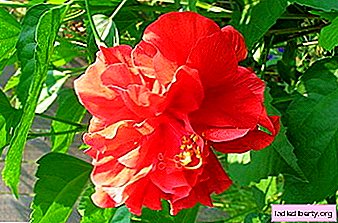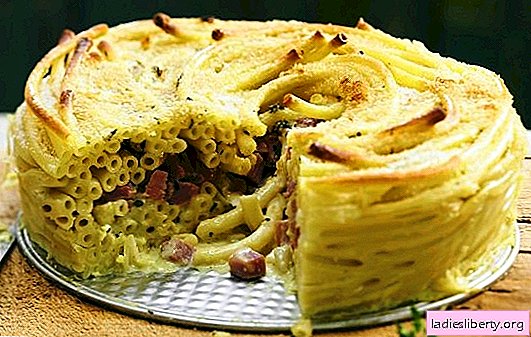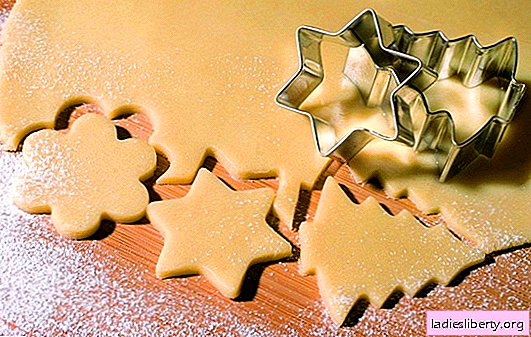
Kind Hibiscus (Hibiscus) of the family Malvaceae (Malvaceae) includes, according to various sources, from 150 to 220 species of plants, both wild and cultivated. It is believed that they come from Southeast Asia, but in nature they can also be found in Africa and America. There, in the wet floodplain meadows, you can admire the whole thickets of this beautiful plant with large, elegant, brightly colored flowers.
In Hawaii, hibiscus is called the "flower of beautiful women" and is considered a national plant, in Brazil one of its species is called "princess earrings". However, in places of their natural growth, these flowers perform not only a decorative function. Their young leaves and shoots are eaten as vegetables; various medicines are produced from seeds, leaves, fruits and roots; of flowers - black hair dye and purple - for the food industry. Favorite tea of many "Karkade" also refers to the gifts of hibiscus.
In culture, you can most often find Syrian hibiscus (H. syriacus), hybrid hibiscus (H. hybridus) and Chinese hibiscus (H. rosa-sinensis).
For growing in the garden in our conditions, Syrian hibiscus is most suitable, since it is cold-resistant. This is a beautiful plant with erect branches, reaching a height of 3 m, which begins to bloom in June and pleases the eye with its exquisite flowers until late autumn. It is best to choose mixed flower beds from light-loving herbaceous perennials that bloom in mid-summer for its planting. Hibiscus grows slowly, so it grows to its usual size in a few years. It is interesting that each of its flowers can bloom for only one day, but it has so many buds that they last for several months of lush flowering.
Hibiscus - growing and care
For growing hibiscus in open ground, climatic zones with mild winters are suitable. Without shelter, he can winter only in the southern regions, in other conditions he must be protected from winter frosts to prevent freezing of the aerial parts. However, even in this case, with the advent of spring, the plant grows again and flowering occurs on new shoots. Leaves on hibiscus bushes appear only in late spring, so it is not worthwhile to draw conclusions about the safety of the plant after wintering. Frosts have the greatest influence on young plants. Therefore, when planting hibiscus in the fall, it is necessary to mulch the earth around it in the first winter and tie a bush with fir spruce branches. In regions where there are severe frosts for a long time, it is better to plant hibiscus in the spring.
The place for planting should be chosen sunny and protected from the wind, with loose soil without stagnant moisture, rich in humus. Hibiscus, which is provided with good care, can live 20 years or more, as it grows, it becomes more winter-hardy and gets used to our temperature.
Hibiscus - transplant and breeding
The transplant should be carried out in early spring, before the flowering plants. First you need to do its pruning in order to activate branching and flowering. Pruning branches produce about two-thirds or half their length. After transplanting, if the plant is provided with good lighting and plentiful watering, in a year you can get a flowering plant.
Garden hibiscus is propagated by dividing the bush, layering, cuttings and seeds. The easiest way is propagation by cuttings. They are cut from June to August from the tops of young growth, having 2-3 internodes, processing sections with growth stimulants. Then the cuttings are rooted in containers with a soil mixture prepared from a mixture of peat with sand, providing them with a content at a temperature of 22-25 ° C. About a month later, the cuttings take root, and after that they must be planted in small pots with a soil mixture prepared from 2 parts of humus and taken in 1 part of leaf and turf soil and sand, and watered with warm water.
Sowing of seeds is carried out in January-March, after soaking them for 12 hours in epin. Sown in a soil mixture, for the preparation of which peat and sand are taken. The sowing container should be covered with glass and maintained at a temperature of 25 ° C to 27 ° C, periodically spraying and aerating. After their germination and formation of seedlings of two or three leaves, they should be dived into small pots. If you grow hibiscus from seeds, it will begin to bloom and bear fruit in 3-4 years of life.
Hibiscus - Diseases and Pests
Like any other plant, hibiscus reacts to errors in care with its appearance and state of health. So, buds that did not open and fell off indicate a lack of nutrients and insufficient watering.
Falling of the lower leaves indicates the occurrence of leaf chlorosis due to the fact that the water used to water the flower contains an excess of calcium chlorine, and an insufficient amount of nitrogen and iron. If the hibiscus has lush foliage, but there are no flowers, then the plant received too many fertilizers with a high nitrogen content. Due to lack of moisture, its leaves can droop and become lethargic.
Hibiscus is also damaged by pests, among which the aphids, thrips, whiteflies, and spider mites are most common. The most effective way to combat them is to treat with systemic insecticides, for example, Actellic.
If you are able to understand hibiscus and provide it with suitable conditions for growth and development, then this flower of love and beauty for many years will become the pride and decoration of your garden or courtyard, invariably delighting you with beautiful bright flowers throughout the summer.











